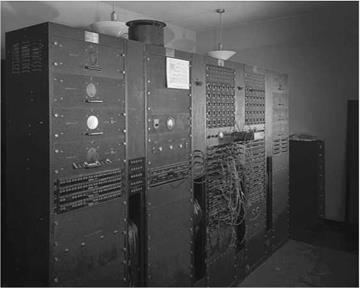Flow Analogies
In this chapter we will discuss some experimental techniques for flow simulation and visualization, including the Hele-Shaw flow [1], shallow water, hydraulic analogy, electric analogy and analog computers. In each case, the theory and the limitation will be studied.
13.1 Hele-Shaw Flows
Consider a slow motion of fluid between two parallel plates separated by a small distance 2h. If a cylindrical body of arbitrary cross-section is inserted between the two plates at right angle, from wall to wall, the streamline pattern will be the same as that of potential flow around the same shape!
The creeping flow in general is dominated by viscous effects and inertia terms can be neglected leading to the Stokes equations for incompressible flows
Vp = pV2V and V. V = 0 (13.1)
The no slip and no penetration boundary conditions on the two walls are satisfied with V = 0.
Taking the divergence of the gradient of pressure yields the Laplacian equation, namely
V. (Vp) = V2p = pV. (V2v) = pV2 (V. V) = 0 (13.2)
Hence the pressure p(x, y, z) is a potential function.
Now, taking the rotational of the equation yields
Va (Vp) = 0 = pV2 (VaV) = pV2ш (13.3)
© Springer Science+Business Media Dordrecht 2015
J. J. Chattot and M. M. Hafez, Theoretical and Applied Aerodynamics,
DOI 10.1007/978-94-017-9825-9_13
Hence, the z-component of the rotational vector satisfies
|
|
![]()
Moreover, for two dimensional flows, a stream function exists such that u = Фу and v = – фх, which satisfies
|
|
|
|
|
|
Therefore, the governing equation for ф is
V4 ф = 0 (13.6)
the biharmonic equation.
Next, for a thin film of fluid, such that h < l, where l is a characteristic length (i. e. cylinder diameter), the above equations are further simplified, because of the strong gradient of the velocity in the normal z-direction. The governing equations become
![]()
![]() д p д2и д p d2v д p д2 w
д p д2и д p d2v д p д2 w
дх – дz2 дy ^ дz2 дz ^ дz2
and
ди дv д w дх + д y + дz 0
with the condition that
![]()
![]()
![]() (13.9)
(13.9)
Since w is much smaller than the (u, v) components, дp/дz is much smaller that the other components of the pressure gradient. Hence, to a first approximation p = p(x, y). The u and v components are obtained via integration in the z-direction and applying the no slip conditions at both z = ±h gives
u = – Т-дг(h2 – z2) (13.10)
2[л дх
Notice that the ratio v/u does not depend on z, i. e. the direction of the flow and the streamline patterns are independent of z. Notice also, the stress tensor
is simplified to be
Tij = – pSij (13.13)
since the pressure magnitude is p = O (pUl/h2) and the tangential stresses are of order O (pU/h). Thus, in a thin film, the normal stresses are dominant. At the cylinder surface, with this model, only the tangency (no penetration) condition is satisfied and the no slip condition is not satisfied.
From the above results for u and v, upon elimination of the pressure, one obtains
Thus, the flow past a cylinder, at any given z, correspond to a 2-D irrotational flow past that cylinder.
 |
||
Notice the average velocity components are
where V and p depend only on x and y.
Therefore, a two-dimensional potential flow exists for which the potential function is proportional to the pressure. The above relation is of the same form as Darcy’s law for flows in porous media.
Applications in different fields can be found in a recent book by Gustafsson and Vasilev [2] on “Conformal and Potential Analysis in Hele-Shaw Cells.”
Hele-Shaw in 1898 used this analogy to obtain experimental patterns of streamlines in potential flow about arbitrary 2-D bodies, by introducing coloring matter at a few points at the inlet section, for visual demonstration.
There are, however, some limitations. The circulation Г around any closed curve C lying in a (x, y)-plane, whether enclosing the cylinder or not, must be zero. This is clear from the definition
1 2 2 d p d p 1 2 2 d p
Г = udx + v dy = —- (h2 — z2) dx + dy = —- (h2 — z2) ds = 0
2^ dx dy 2p ds
(13.18)
since p is a single valued function of x and y.
Visualizations of potential flows in simply connected domains, for example, flow in a diffuser, are possible.
Ironically, potential streamlines are visualized using viscous dominated flows. beautiful pictures of Hele-Shaw flows past a circle, and inclined plate, a Rankine half-body, inclined airfoil, a rectangular block on a plate, uniform flow normal to a plate, can be found in Van Dyke’s Album of Fluid Motion [3]. Other pictures for flow past an ellipse and past symmetrical Joukowski airfoil at zero angle of attack can be found in Visualized Flow, compiled by the Japan Society of Mechanical Engineers. For more details of the theory, see Schlichting [4], Batchelor [5] and Acheson [6]. Two examples of Hele-Shaw flows are presented, the flow past a flat plate at high incidence and the flow past a rectangular block. In Fig. 13.1, the flat plate produces a flow that is antisymmetrical with respect to the plate center. Hence, the Kutta – Joukowski condition at the trailing edge is not satisfied and there is no circulation.
|
Fig. 13.1 NASA/Ames reeves electronic analog computer (1949) (from http://www. nasa. gov/ centers/ames/multimedia/images/2010/iotw/reeves. html) |
The flow past a rectangular block is shown in Fig. 13.2. No visible separation occurs with the creeping flow regime.
Hele-Shaw flow and pattern formation in a time-dependent gap is studied in Ref. [3].












